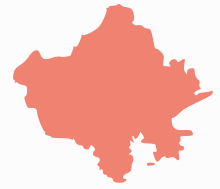Pushkar
| Pushkar पुष्कर | |
|---|---|
| town | |
|
Pushkar from above | |
| Nickname(s): Tirthraj Pushkar तीर्थराज पुष्कर | |
 Pushkar Location in Rajasthan, India | |
| Coordinates: 26°30′N 74°33′E / 26.5°N 74.55°ECoordinates: 26°30′N 74°33′E / 26.5°N 74.55°E | |
| State | Rajasthan |
| District | Ajmer |
| Elevation | 510 m (1,670 ft) |
| Population (2001) | |
| • Total | 14,789 |
| Languages | |
| • Official | Hindi |
| Time zone | IST (UTC+5:30) |
Pushkar (Hindi: पुष्कर) is a town in the Ajmer district in the Indian state of Rajasthan. It is situated 14 km (8.7 mi) northwest of Ajmer at an average elevation of 510 m (1,670 ft) and is one of the five sacred dhams (pilgrimage site) for devout Hindus. According to Hindu theology, the pond at the Katas Raj temple Near Choa Saidan Shah in Chakwal District of Pakistan has a theological association with Shiva; it was formed by the tears of Lord Shiva which he is believed to have shed after the death of his wife, Sati. The story goes that when Sati died, Shiva cried so much and for so long, that his tears created two holy ponds – one at Pushkara in Ajmer in India and the other at Ketaksha, which literally means raining eyes, in Sanskrit. It is from this name that the word Katas is derived. It is often called "Tirth Raj" – the king of pilgrimage sites – and has in recent years become a popular destination for foreign tourists.
Pushkar is one of the oldest existing cities of India. It lies on the shore of Pushkar Lake. The date of its actual origin is not known, but legend associates Brahma with its creation.
Pushkar has many temples. Most of the temples are not very old because many temples were destroyed during Muslim conquests in the area.[1] Subsequently, the destroyed temples were rebuilt. The most famous among all is the Brahma Temple built during the 14th century CE. Very few temples to Lord Brahma exist anywhere in the world. Other temples of Brahma include Bithoor in Uttar Pradesh, India; Khedbrahma in Gujarat, India; village Asotra near Balotra city of Barmer district in Rajasthan; Uttamar Kovil (one of the Divya Desams) near Srirangam, Tamil Nadu; Carambolim near Valpoi in Goa, Mother Temple of Besakih in Bali, Indonesia; and Prambanan in Yogyakarta, Indonesia. The Pushkar lake has 52 ghats where pilgrims descend to the lake to bathe in the sacred waters.
Pushkar is also famous for its annual fair (Pushkar Camel Fair) held in November.
Etymology
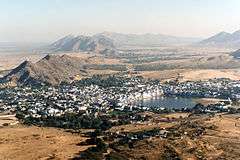
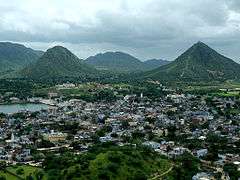
Pushkar in Sanskrit means blue lotus flower.[2] Hindus believe that the gods released a swan with a lotus in its beak and let it fall on earth where Brahma would perform a grand yagna. The place where the lotus fell was called Pushkar. Pushkar word may be derived from word 'Pushkarni'means- lake. It may be derived from word Pushpa means flower and Kar means hand.
History
According to legend, Brahma was in search of a place for Mahayagna and he found this place suitable. After a long time, Brahma came to known that a demon, Vajranash, was killing people here so the Lord intoned a mantra on a lotus flower and killed the demon. During this process the parts of flower fell on three places which were later known as Jyaistha, Madhya and Kanistha Pushkar. After this Brahma performed a yagna to protect this place from demons. The consort of Brahma, Savitri, were needed to offer Ahuti for the yagna but she was not there that time so Gayatri, a Gurjar girl, was married to brahma and performned yagna. This act made first wife of Brahma, Savitri, angry and she cursed Brahma saying that he would be worshiped in Pushkar only.[3][4]
There are still priests from the Gurjar community in Pushkar temple, known as Bhopas.[4]
It is also the venue of the annual Pushkar Camel Fair. In 1901, the town was part of the Rajputana Agency had a population of 3,831.[5]
Demographics
As of 2001 India census,[6] Pushkar had a population of 14,789. Males constitute 54% of the population and females 46%. Pushkar has an average literacy rate of 69%, higher than the national average of 59.5%: male literacy is 77%, and female literacy is 60%. In Pushkar, 14% of the population is under 6 years of age.
Transport
.jpg)
Air
The nearest airport from Pushkar is Sanganer Airport at Jaipur at distance of 146 km (91 mi). Jaipur is well connected with all the major cities in India.
Road
Pushkar is connected with Ajmer by Pushkar road which goes through aravalli range. The mountain portion road which separate Pushkar from Ajmer City is locally known as Pushkar Ghati. Pushkar is 11 km (6.8 mi) from Ajmer. The govt. transportation commonly controlled by Rajasthan Roadways, however the significant share of the transportation is controlled by private transportation services.
Rail
PUHT/Pushkar Terminus started operations in January 2012 and connects to the nearest large railway station, Ajmer. Only train operates is 59607/Ajmer - Pushkar Passenger (UnReserved) on Avg. Speed of 22 km/hr
Tourist attractions

- The Sri Sawai Bhoj Temple[7]
- Jagat Pitta Shri Brahma temple
- Gautama Maharishi temple
- Paap Mochani Gayatri
- Atpateshvar Mahadev
- Varaha temple
- Apteshwar Mahadev temple
- Savitri temple
- Ayurvedic healing by Dr BL Mishra, Government ayurvedic hospital.
- Baba the Cosmic Barber
- Temple of Rangji (New and Old) or Shri Vaikunthnathji
- Man Mahal
- Gurudwara Singh Sabha
- Aalo Baba Kal Bhai Rav Temple.
- 108 Mahadev Mandir. it has a very beautiful inner sanctum having lord shiva's idol similar to pashupatinath temple. the inner sanctum is surrounded by 108 small shiva idols.
- Varah Temple. This temple is to God Vishnu. It is one of the most visited temples in Pushkar city. It is said that Lord Vishnu gave a visit to this area to kill an atrocious demon Hirnayaksha.
Fairs
Pushkar Fair
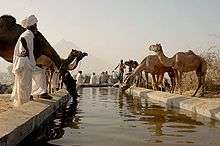
Pushkar fair continues for five days and these five days are a period of relaxation and merry-making for the villagers. This fair time is the most busy time for them, as this is one of the largest cattle fairs in the country. Animals, including over 50,000 camels, are brought from miles around to be traded and sold. Trading is brisk as several thousand heads of cattle exchange hands. All the camels are cleaned, washed, adorned, some are interestingly shorn to form patterns, and special stalls are set up selling finery and jewellery for the camels. Camels at the Pushkar fair are decorated with great care. They wear jewellery of silver and beads. There are silver bells and bangles around their ankles that jangle when they walk. An interesting ritual is the piercing of a camel's nose. It has more than 400 temples including the only one temple in India dedicated to the Hindu God Lord Brahma, the Creator of the Universe.
According to Hindu religion, after visiting all the Hindu pilgrim towns and temples (Four Dhams), if Pushkar is not visited for worship, then salvation is not achieved. According to the Hindu calendar Pushkar Fair commences in Nawami (ninth day of fortnightly phases of moon) and ends in Purnima (Full Moon) in the month of Kartika (October or November according to the lunar calendar). In Pushkar, one of the biggest Cattle Fair is also held for trading purposes and the best cattle in all categories are awarded. Countless people in their colourful attire gather to take a dip in the Holy Lake and pray to the deities. The whole town comes alive with vibrant folk music and dances, magic shows, horse and camel races and various other traditional entertainment competitions. Pushkar, with more than 12 local fairs and festivals of 10–15 days duration is a year round destination. It is a mellow town by the great lake of Pushkar amidst the perfume of jasmine and rose flowers. About 4,000 to 6,000 visitors from all over the world come to Pushkar every day.[9]
Camel Safari in Pushkar
Tourists can explore the rugged terrain of the Great Indian Desert of Thar using camels. The Aravalli Range here is one of the world's oldest mountain ranges, and has sandy fields, small dunes, beautiful hills and mesmerizing sunrises and sunsets.
The camel safaris in Pushkar will take tourists to destinations where they will witnesses small villages along the way and during crop harvesting, the views are exceptionally enticing.
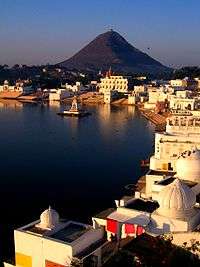
Ajmer is the nearest tourist attraction that lies outside the city boundaries of Pushkar.
Located 27 kilometres away from Ajmer, there is Kishangarh, famous for its miniature paintings, more popularly known as Bani Thani.
Pushkar Lake – The prime attraction of Pushkar is the Pushkar Lake which is considered sacred like the Mansarovar Lake in Tibet. Pushkar has become a place of Hindu pilgrimage because of this holy lake. Legend has it that this lake was consecrated to Lord Brahma, the creator of the universe when a lotus dropped from his hand into the vale and a lake emerged in that place.
Brahma Temple – The most important temple in Pushkar is the Temple of Lord Brahma, one of the holy trinity of Hinduism. The temple enshrines a life-size idol of Lord Brahma.
Savitri Temple- This temple that is located at the top of the Ratnagiri Hill is dedicated to Savitri, the wife of Lord Brahma. The temple houses a statue of Goddess Savitri.
Old Pushkar- Old Pushkar lake is rebuilt and is located around 5 km from Pushkar lake. According to the ancient texts, Old Pushkar has equal cultural and religious significance for the pilgrims.

See also
References
- ↑ "Al-Hind: The Slavic Kings and the Islamic conquest, 11th-13th centuries", Page. 326
- ↑ A. Kalyanaraman. Aryatarangini, the saga of the Indo-Aryans, Volume 2. Asia Pub. House, 1970. p. 551.
- ↑ Pilgrim Places of India. Prabhat Prakashan. p. 30. ISBN 8187100419, ISBN 978-81-87100-41-6.
- 1 2 Social science probings, Volume 10. People's Pub. House. 1993. p. 49.
- ↑ "Pushkar". The Imperial Gazetteer of India. 1909. p. v. 21, 1.
- ↑ "Census of India 2001: Data from the 2001 Census, including cities, villages and towns (Provisional)". Census Commission of India. Archived from the original on 2004-06-16. Retrieved 2008-11-01.
- ↑ "Ajmer-Pushkar places to visit".
- ↑ Pushkar Fair The Wall Street Journal (November 14, 2013)
- ↑ ABOUT PUSHKAR. brahmatemplepushkar.com
External links
| Wikimedia Commons has media related to Pushkar. |
- Pushkar Camel Fair & The Pushkar Mela
-
 Chisholm, Hugh, ed. (1911). "Pushkar". Encyclopædia Britannica. 22 (11th ed.). Cambridge University Press.
Chisholm, Hugh, ed. (1911). "Pushkar". Encyclopædia Britannica. 22 (11th ed.). Cambridge University Press. -
 Pushkar travel guide from Wikivoyage
Pushkar travel guide from Wikivoyage - Pushkar map Important places in Pushkar
- The Pushkar Camel fair http://fotofoyer.com/pushkar-camel-fair-photography-tour-november-2016/


